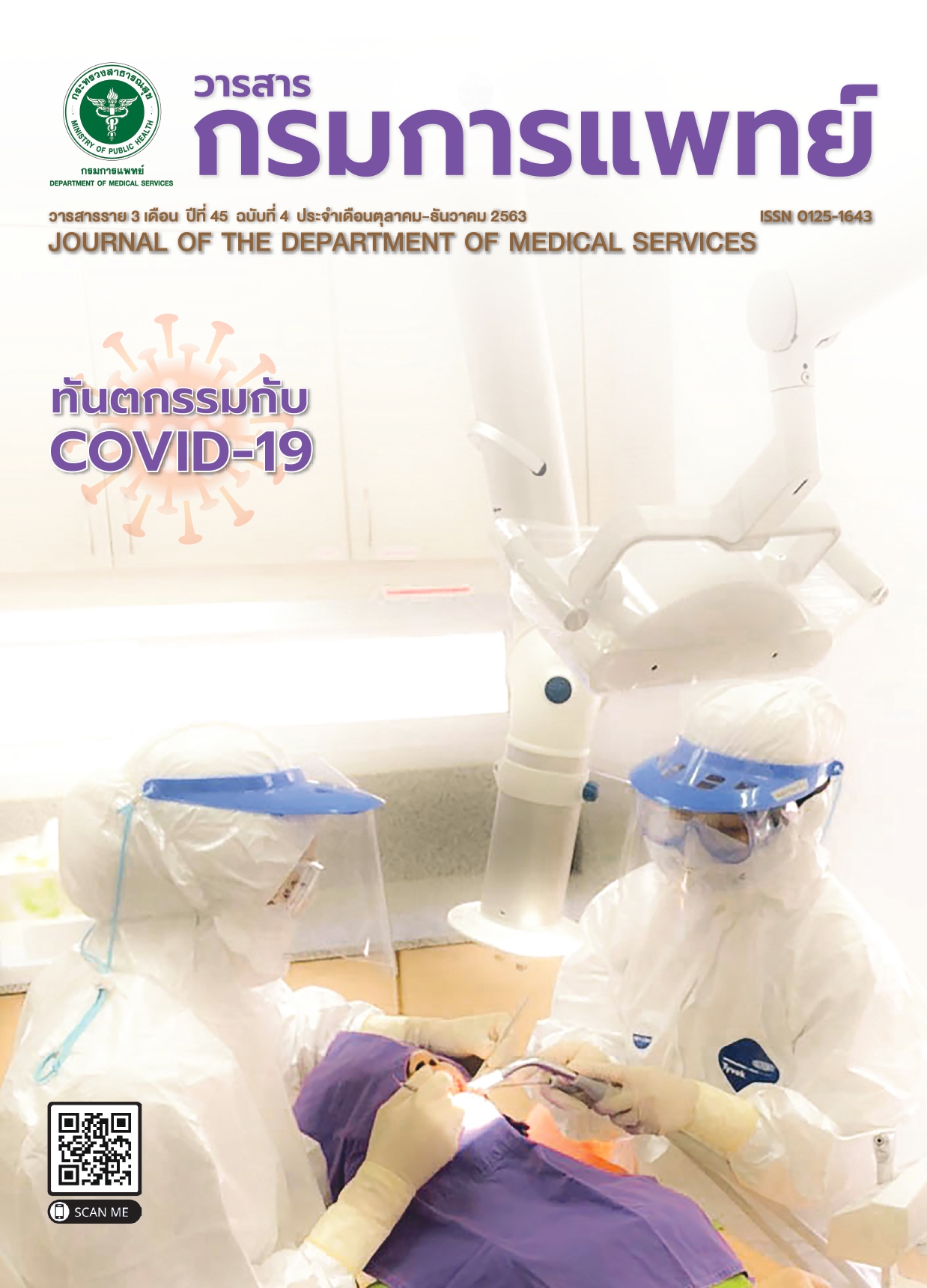The Study of Antimicrobial Resistance (AMR) and ESKAPE Bacteria Have Been Reported In -Healthcare Associated Bloodstream Infections (HA-BSI) by WHONET Program in Nopparat Rajathanee Hospital, 2017-2018
Keywords:
Antimicrobial resistance, AMR, Nopparat Rajathanee Hospital, HA-BSI, ESKAPE, MDR, CRE, VREAbstract
Background : Antimicrobial resistance (AMR) is the leading cause of Healthcare-associated infections (HAIs) throughout the world. The mostly AMR is ESKAPE bacteria. Effects include high mortality and morbidity rates. Effective surveillance & response for AMR might be prevented and responded to HAIs and Outbreaks with AMR.
Objective : This study was to explore the situation of antimicrobial resistance and ESKAPE bacteria in patients with bloodstream infection.
Method : Medical records of hospitalized patients during January 2017 to December 2018 who had at least one of positive blood cultures were reviewed by the infection control nurse team. The surveillance reports of Healthcareassociated blood stream infection (HA-BSI) was matched pair with the results of the positive blood cultures to analyses the situation of them.
Results : The WHO-NET program could be help with easier and faster data analysis. A total of 1,862 patients with a positive blood cultures were reviewed and found Staphylococcus coagulase negative were the most bacteria during two years. The ESKAPE bacteria met 447 patients (24.0%) which 23.3% (104/447) met multidrug resistance (MDR), 2.8% (17/607) met carbapenem resistance Enterobacteriaceae (CRE) and 3.6% (2/56) met vancomycin resistance Enterococcus (VRE). The proportion of Enterococcus BSI case that was resistance to vancomycin was 1.3% (1/79) which is Central-line associated blood stream infection. The proportion of Klebsiella pneumonia BSI case that was resistant to carbapenem was 7.6% (6/79) which is a Central-line associated blood stream infection were 66.7% (4/6).
Conclusions : Escherichia coli was the most pathogens of HA-BSI (10/79) which 50.0 % (5/10) met antimicrobial resistance. However, 43% (34/79) of HA-BSI is ESKAPE bacteria which 41.2% (14/34) met antimicrobial resistance. Moreover, 64.3% (9/14) of ESKAPE antimicrobial resistance is Central-line associated blood stream infection. These data are the baseline for decrease AMR which response to the policy of the Government. These will be beneficial adapt to multimodal for decreasing the HA-BSI.
References
Thamlikitkul V. Handbook for prevention and control to antimicrobial resistance in hospitals. Health Systems Research Institute,ThaiHealth Promotion Foundation, Faculty of Medicine Siriraj Hospital, The Government Pharmaceutical Organization, International Development Research Center (IDRC), Canada; 2015:120
Sumpradit N, Suttajit S, Poonpolsub S, Chuanchuen R, Prakongsai P. Landscape of antimicrobial resistance situation and action in Thailand. Bangkok: Aksorn graphic and design publisher house; 2015:145
Chalermchaikit T, Lertworapreecha M, Sasipreeyajan J.Antimicrobial-Resistant Patterns of Salmonella in Thai Rural-Chicken and Farmed-Broilers. J Thai Vet Med Assoc 2005;1:56.
O’Neill J. Review on antimicrobial resistance. Tackling drug resistance globally; final report and recommendations ;2016:84.
Centers for Disease Control and Prevention. CDC—ANTIBIOTIC RESISTANCE.[Internet]. 2017 [cited 2017 Feb 6].Available from: https://www.cdc.gov/budget/documents/fy2017/ar-factsheet.pdf.
Phumart P, Thamlikitkul V, Riewpaiboon A, Prakongsai P, Limwattananon S, Health and economic impacts of antimicrobial resistance infections in Thailand; A preliminary study. Journal of Health System Research 2012;6:352-60.
World Health Organization. Global Priority List of Antibiotic-Resistant Bacteria to Guide Research, Discovery and Development of New Antibiotics. [Internet]. 2017 [cited 2017 Feb 6]. Available from: http://www.who.int/
WHO. WHO Collaborating Centre for Surveillance of Antimicrobial Resistance WHO Collaborating Centres Global database. [Internet]. [cited 2018 Mar 4]. Available from: http://apps.who.int/whocc/Detail.aspx cc_ref=USA-181&.
Agarwal A, Kapila K, Kumar S. WHONET Software for the Surveillance of Antimicrobial Susceptibility. Med J Armed Forces India 2009;65:264-6.
Frieri M, Kumar K, Boutin A. Antibiotic resistance. J Infect Public Health 2017;10:369-78.
Kheder S. Application of WHONET 5 Software for the Surveillance and Analysis of Antimicrobial Resistance in A Sudanese Hospital 2012. J Pharm Biomed Sci2012;6:1-10.
Natale A, Stelling J, Meledandri M, Messenger LA, D’Ancona F. Use of WHONET-SaTScan system for simulated real-time detection of antimicrobial resistance clusters in a hospital in Italy, 2012 to 2014. Euro Surveill 2017;22:30484.
Vong S, Anciaux A, Hulth A, Stelling J, Thamlikitkul V,Gupta S, et al. Using information technology to improve surveillance of antimicrobial resistance in South East Asia.BMJ 2017;358:j3781.
Bureau of Information office of the permanent Secretary of MOPH. The Department of Medical Science collaborated with the sixty hospitals to monitor antimicrobial resistance with the WHONET program. [Internet]. 2010 [cited 2018 Mar 12]. Available from: http://pr.moph.go.th/iprg/ include/admin_hotnew/show_hotnew.phpidHot_new=66068.
MGR online. The Ministry of Public Health warns that the situation of antimicrobial resistance in the country is likely to increase in 2014. [Internet]. [cited 2018 Apr 10].Available from: http://www.manager.co.th/asp-bin/Print-News.aspx?NewsID=9570000068267.
Centers for Disease Control and Prevention. National Healthcare Safety Network (NHSN) Patient Safety Component Manual. [Internet].2017 [cited 2017 Oct 05].Available from:https://www.cdc.gov/nhsn/pdfs/pscmanual/pcsmanual_current.pdf.
Gandra S, Tseng KK, Arora A, Bhowmik B, Robinson ML,Panigrahi B, et al. The Mortality Burden of Multidrug-resistant Pathogens in India: A Retrospective, Observational Study. Clin Infect Dis 2018;69:563-70.
Bumrungsak R, Watagulsin P, Kasemsaisuwan A, Tantilipikara P, Sammanmit Y, Sawanpanyalert N. Surveillance for healthcare-associated bloodstream infections (HA-BSIs).Journal of the Department of Medical Service. 2018; 43:125-9.
Founou RC, Founou LL, Essack SY. Clinical and economic impact of antibiotic resistance in developing countries:a systematic review and meta-analysis. PloS One 2017;12:e 0189621.
Lim C, Takahashi E, Hongsuwan M, Wuthiekanun V, Thamlikitkul V, Hinjoy S, et al. Epidemiology and burden of multidrug-resistant bacterial infection in a developing country. Elife 2016;5:e18082.
Ziegler MJ, Pellegrini DC, Safdar N. Attributable mortality of central line associated bloodstream infection: systematic review and meta-analysis. Infection 2015;43:29-36.
Infection Control Committee. Annal Report 2017 Surveillance for Healthcare Associated Infection. Nopparat Rajathanee Hospital: The nursing of Infection prevention and control Department;2017.
Infection Control Committee. Annal Report 2018 Surveillance for Healthcare Associated Infection. Nopparat Rajathanee Hospital: The nursing of Infection prevention and control Department;2018.
Pathology group of Nopparat Rajathanee Hospital. Annal Report 2016 of Antimicrobial Susceptibility.Nopparat Rajathanee Hospital: The Department of Microbiology;2016.
Pathology group of Nopparat Rajathanee Hospital. Annal Report 2017 of Antimicrobial Susceptibility.Nopparat Rajathanee Hospital: The Department of Microbiology;2017.
Pathology group of Nopparat Rajathanee Hospital. Annal report 2018 of Antimicrobial Susceptibility.Nopparat Rajathanee Hospital: The Department of Microbiology;2018.
Downloads
Published
How to Cite
Issue
Section
License
บทความที่ได้รับการตีพิมพ์เป็นลิขสิทธิ์ของกรมการแพทย์ กระทรวงสาธารณสุข
ข้อความและข้อคิดเห็นต่างๆ เป็นของผู้เขียนบทความ ไม่ใช่ความเห็นของกองบรรณาธิการหรือของวารสารกรมการแพทย์



